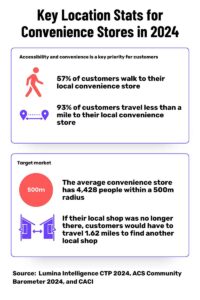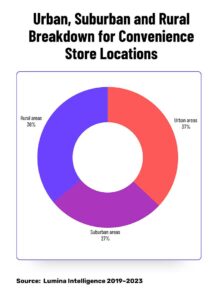You won’t be surprised to learn that, like most retail or hospitality ventures, location can make or break a convenience store’s success.
Drawing upon the ACS’s latest Local Shop Report 2024, CoGoGo looks at the latest facts and figures on convenience store locations, helping you to identify the most promising areas to invest in.
How to choose the best location for your convenience store?
Proximity to key markets
Stores should ideally be situated near residential areas to ensure easy access for customers, as convenience is at the heart of their business model. High footfall areas, such as busy streets or near transport hubs, can help attract more customers.
According to Lumina Intelligence’s UK CTP 2024 report, 57% of customers walk to their local convenience store, highlighting the importance of choosing a location within walking distance of residential areas. Additionally, 65% of customers travel less than a quarter of a mile to reach a store, and a total of 93% travel less than a mile. This shows that most convenience store shoppers prefer easily accessible locations close to their homes.

Few-to-no competitors in a ~1.5 mile radius
If their local convenience store was no longer there, customers would on average have to travel 1.62 miles to find another local shop – that was the discovery of the Association of Convenience Stores Community Barometer 2024.
What does this mean? It means that most convenience stores operate with no major competitors in a ~1.5 mile radius. When you’re weighing up different convenience stores to buy, you’ll therefore want to consider the local competitive landscape. In particular, you’ll want to avoid locating close to any express supermarkets.

Urban, suburban or rural
Urban areas have the highest percentage at 37% of convenience store locations, slightly edging out rural areas (36%) and substantially more than suburban areas (27%), according to Lumina Intelligence 2019–2023.
Different areas, however, will have different advantages. Urban centres typically have higher population density and more pedestrian activity, which can translate to more spontaneous purchases – a key factor for convenience store success. But rural stores often provide the only shopping option for the local community, translating to a captive market and low competition.
Balancing the trade-off between high footfall and higher rents/commercial mortgages
However, you must balance the benefits of high traffic with the potential challenges of higher rent/mortgage costs and competition from nearby stores. Prime locations often come with a trade-off between increased revenue and reduced profitability due to higher overheads.
According to Lumina Intelligence 2019–2023, most (40%) convenience stores are located on a small parade, with up to five retail/service businesses close by, and 33% are isolated stores with no other retail/service businesses close by. 11% are located on a larger parade or a high street with up to 10 retail/service businesses close by.
What might we take from this? Small parades seem to be the preferred option, possibly offering a good balance of visibility and manageable competition. Isolated stores are also common, suggesting that serving a local community without direct competition can be viable. Meanwhile, far fewer stores choose high-traffic areas like large parades or high streets, likely due to higher costs and competition.
Controlling inventory by being close to distribution centres
With 58% of retailers relying on deliveries for the majority of their stock, proximity to reliable distribution routes is crucial to ensure consistent product availability.
15% of retailers source most of their products from a cash-and-carry, indicating that locations near cash-and-carry wholesalers could be advantageous for store owners who prefer to manage inventory themselves. Additionally, 14% of retailers use both delivery and cash-and-carry equally, so being situated within reach of both distribution centres and a local cash-and-carry would provide flexibility in stocking.
Close to home
If you’re planning on taking a hands-on approach with your new convenience store, you won’t want to be commuting half-way across the country.
Indeed, typical convenience stores are open 7am to 10pm, and 7% operate 24 hours a day. This means you’ll want to be in easy commuting distance so that you can pick up the slack when staffing issues arise.
Another advantage of running a convenience store in your local community is that you likely already have a ready-made customer base from your local network.


